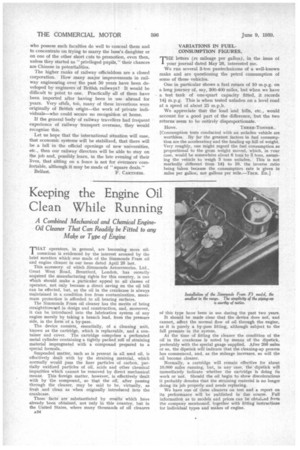Keeping the Engine Oil Clean While Running
Page 52

If you've noticed an error in this article please click here to report it so we can fix it.
A Combined Mechanical and Chemical EngineOil Cleaner That Can Readily be Fitted to any Make or Type of Engine
THAT operators, in general, are becoming more oilconscious is evidenced by the interest aroused by the brief mention which was made of the Simmonds Fram oil and engine cleaner in our issue dated April 28 last.
This accessory of which Simmonds Aerocessories, Ltd., Great West Road, Brentford, London, has recently acquired the manufacturing rights for this country, is one Which should make a particular appeal to all classes of operator, not only because a direct saving on the oil bill can be effected, but, as the oil in the crankcase is always maintained in a condition free from contamination, maximum protection is afforded to all bearing surfaces.
The Simmonds Fram oil cleaner has the merits of being straightforward in design and construction, and, moreover, it can be introduced into the lubrication system of any engine merely by taking a branch lead, from the pressure side, in the form of a by-pass.
The device consists, essentially, of a cleaning unit, known as the cartridge, which is replaceable, and a con tainer and cover. The cartridge comprises a perforated metal cylinder containing a tightly packed roll of straining material impregnated with a compound prepared to a special formula.
Suspended matter, such as is present in all used oil, is effectively dealt with by the straining material, which normally would pass the finer particles of carbon, par tially oxidized particles of oil, acids and other chemical impurities which cannot be removed by direct mechanical means. This foreign matter, however, is effectively dealt with by the compound, so that the oil, after passing through the cleaner, may be said to be, virtually, as fresh and clean as when originally introduced into the crankcase.
These facts are substantiated by results which have already been obtained, not only in this country, but in the United States, where many thousands of oil cleaners A34 of this type have been in use during the past two years.
It should be made clear that the device does not, and cannot, affect the normal flow of oil through the engine, as it is purely a by-pass fitting, although subject to the full pressure in the system. At the time of fitting the cleaner the condition of the oil in the crankcase is noted by means of the dipstick, preferably with the special gauge supplied. After 200 miles or so, the dipstick will indicate that the cleaning-up process has commenced, and, as the mileage increases, so will the oil become cleaner.
Normally, a cartridge will remain effective for about 10,000 miles running, but, in any case, the dipstick will immediately indicate whether the cartridge is doing its work or not. Should the oil begin to show discolorations it probably denotes that the straining material is no longer doing its job properly and needs replacing. We have one of these cleaners on test and a report on its performance will be published in due course. Full information as to models and prices can be obtaieed from the company mentioned, together with fitting instructions for individual types and makes of engine.




















































































